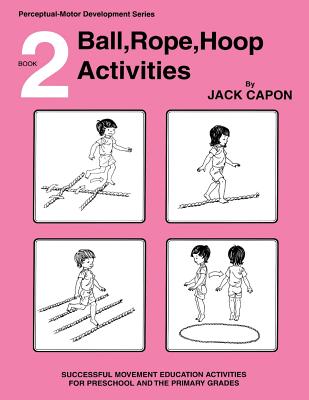Ball, Rope, Hoop Activities: Book 2

Ball, Rope, Hoop Activities: Book 2
This is the Second in a series of Five motor development activity books in the Perceptual-Motor Development Series covering preschool and the primary grades. This book is divided into 3 Parts: Part 1--Ball Activities; Part 2--Rope Activities; and Part 3--Hoop Activities. The book consists of 53 pages and all the activities are sequenced according to difficulty. PART 1 introduces the students to Ball Activities which utilizes a ball which is a marvelous piece of equipment for children. It is the most commonly used equipment in physical education programs as well as in natural play experiences. Its versatility allows it to be manipulated in so many ways. It can be bounced, thrown, rolled, kicked, butted and socked. From infancy, children are eager to be challenged by that round elusive object--the ball. It promises excellent opportunities for developing hand-eye coordination and visual tracking skills necessary for general academic achievement. The ability to handle and control a ball is an important skill for all children. Children who do not have the opportunity to develop these competencies tend to perform poorly and as a result avoid participating in games and sport activities. By implementing a comprehensive program arranged by skill levels that progress from simple to difficult based on sound mechanical principles, the children have more opportunity to be successful. As the child matures, games and sport activities become increasingly popular and an integral part of regular play and recreation. Th child' relationship with his peers and his basic self-image can be strongly influenced by his ability to successfully handle a ball. Basic ball skills insure the proper application of force, accuracy and balance. Children can participate in more advanced and demanding games if they first master basic skills. PART 2 introduces the students to Rope Activities which, as traditionally used in the school physical education programs, serve a rather limited purpose. Their use is confined primarily to rope turning and jumping tasks. Using the rope in movement exploration and perceptual-motor programs affords children the opportunity to explore the physical properties of the rope. The tactile sensation of the rope enhances their language development. They are encouraged to feel the rope, to describe it and to discover what can be done with it. It provides maximum enjoyment and many opportunities for creative expression. Rope jumping is rhythmic and it takes courag
PRP: 94.09 Lei
Acesta este Prețul Recomandat de Producător. Prețul de vânzare al produsului este afișat mai jos.
84.68Lei
84.68Lei
94.09 LeiLivrare in 2-4 saptamani
Descrierea produsului
This is the Second in a series of Five motor development activity books in the Perceptual-Motor Development Series covering preschool and the primary grades. This book is divided into 3 Parts: Part 1--Ball Activities; Part 2--Rope Activities; and Part 3--Hoop Activities. The book consists of 53 pages and all the activities are sequenced according to difficulty. PART 1 introduces the students to Ball Activities which utilizes a ball which is a marvelous piece of equipment for children. It is the most commonly used equipment in physical education programs as well as in natural play experiences. Its versatility allows it to be manipulated in so many ways. It can be bounced, thrown, rolled, kicked, butted and socked. From infancy, children are eager to be challenged by that round elusive object--the ball. It promises excellent opportunities for developing hand-eye coordination and visual tracking skills necessary for general academic achievement. The ability to handle and control a ball is an important skill for all children. Children who do not have the opportunity to develop these competencies tend to perform poorly and as a result avoid participating in games and sport activities. By implementing a comprehensive program arranged by skill levels that progress from simple to difficult based on sound mechanical principles, the children have more opportunity to be successful. As the child matures, games and sport activities become increasingly popular and an integral part of regular play and recreation. Th child' relationship with his peers and his basic self-image can be strongly influenced by his ability to successfully handle a ball. Basic ball skills insure the proper application of force, accuracy and balance. Children can participate in more advanced and demanding games if they first master basic skills. PART 2 introduces the students to Rope Activities which, as traditionally used in the school physical education programs, serve a rather limited purpose. Their use is confined primarily to rope turning and jumping tasks. Using the rope in movement exploration and perceptual-motor programs affords children the opportunity to explore the physical properties of the rope. The tactile sensation of the rope enhances their language development. They are encouraged to feel the rope, to describe it and to discover what can be done with it. It provides maximum enjoyment and many opportunities for creative expression. Rope jumping is rhythmic and it takes courag
Detaliile produsului










